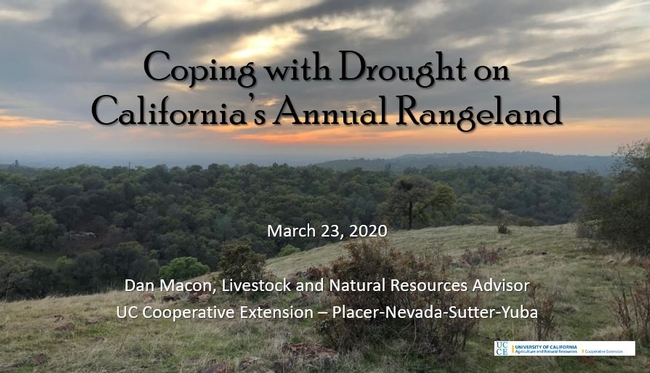As for most of you, I imagine, my world seems upside down at the moment, thanks to the COVID-19 pandemic. As I write this, my youngest daughter is finishing her junior year of high school through online courses. My oldest daughter is completing her second-to-last semester at Montana State University through online courses. And I'm working from the desk in my kitchen. I think I've participated in more video conferences in the last seven days than I've been on in my entire professional life. Based on the advice of medical professionals, we're practicing social distancing, washing our hands, and avoiding large gatherings of people.
Despite COVID-19's dominance of our news cycle and our family conversations, normal, everyday ranching concerns continue. We're at the tail end of our lambing season, which means I'm checking the flock every morning and evening (and more frequently during stormy weather). And we're still worrying about drought.
Yesterday, I was invited to give a presentation during the California-Nevada Drought Early Warning System regular bimonthly webinar. The first two talks covered current conditions and future outlook - and even with the rain and snow we had in our part of the Sierra Nevada and Sacramento Valley last week, we remain in drought conditions. If you're interested in the details, here's a recording of the webinar talks (mine is the third talk in the webinar). The first two talks confirmed my observations. After last week's rain, I checked soil moisture on our winter rangeland - even with three inches of precipitation, the soil was only 50-75 percent saturated (which explains the lack of water in our seasonal creeks). We're starting to see some of our annual grasses head out, indicating the possibility of an earlier-than-normal decline in forage quality. While the snow in the mountains was welcome, our snow water content remains well below average for this time of year.
As I was preparing my talk, I started thinking about how my approach to this year's drought was different from how we managed through 2013-14 (one of the driest years in my memory). While every drought is unique (in terms of severity, timing, and scope), I think I've also learned from my experience. In 2013, we moved our sheep to Rio Vista, where I helped manage a 1900 ewe operation. Here's a quick comparison of the steps we took in the fall of 2013 and early winter of 2014, versus our strategies in 2019-20.
2013-2014 Drought (late germination, followed by extended dry period and warm January temperatures)
- We fed our entire year's supply of alfalfa during lambing (October-December) because there was virtually no grass on our annual rangelands.
- In late January, we sold approximately one-third of our ewes to reduce our forage demand once they started to lamb.
- In mid-February, we moved our sheep back to annual rangeland in the foothills near Auburn (to ensure that the larger commercial flock would have access to rangeland in Rio Vista.
- In late February, we ultrasounded our ewes to determine whether they were pregnant. We sold a handful of open ewes.
- We weaned our lambs four weeks earlier than normal (in late May) to reduce our stocking rate and save dry forage for fall.
2019-2020 Drought (late termination, followed by wet December, dry January, record dry/warm February)
- For the first time ever, we took our ewes to alfalfa stubble in the Sacramento Valley (near Nicolaus) from mid-November until mid-December. While we incurred some additional expense, this allowed us to rest our winter rangeland for an additional 30 days.
- Because we've kept detailed grazing records since the previous drought, we were able to put together detailed, 2-month grazing plans. We identified additional forage resources on our winter rangeland that allowed us to extend our forage supplies.
- We will cull any ewe without a lamb when we ship the flock back to spring/summer pasture in April. We'll cull additional ewes at weaning (for poor mothering, bad udders, missing teeth, etc.)
I'm curious as to how your drought strategies have changed! Are you doing anything differently this year? Is this the first drought you've experienced?
